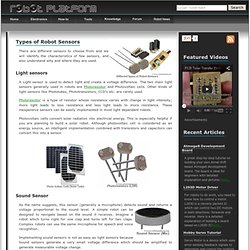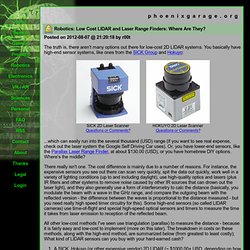

Types of Robot Sensors. There are different sensors to choose from and we will identify the characteristics of few sensors, and also understand why and where they are used.

Light sensors A Light sensor is used to detect light and create a voltage difference. The two main light sensors generally used in robots are Photoresistor and Photovoltaic cells. Other kinds of light sensors like Phototubes, Phototransistors, CCD’s etc. are rarely used. Photoresistor is a type of resistor whose resistance varies with change in light intensity; more light leads to less resistance and less light leads to more resistance. Photovoltaic cells convert solar radiation into electrical energy. Sound Sensor As the name suggests, this sensor (generally a microphone) detects sound and returns a voltage proportional to the sound level. A simple robot can be designed to navigate based on the sound it receives. Temperature Sensor What if your robot has to work in a desert and transmit ambient temperature?
Crazy ideas, irrational projects. Robotics: Low Cost LIDAR and Laser Range Finders: Where Are They?

The truth is, there aren't many options out there for low-cost 2D LIDAR systems. You basically have high-end sensor systems, like ones from the SICK Group and Hokuyo: ...which can easily run into the several thousand (USD) range (if you want to see real expense, check out the laser system the Google Self Driving Car uses). Or, you have lower-end sensors, like the Parallax Laser Range Finder, at about $130.00 (USD), or you have homebrew DIY options. Where's the middle?
There really isn't one. All other low-cost methods I've seen use triangulation (parallax) to measure the distance - because it is fairly easy and low-cost to implement (more on this later). The first option is basically out of most hobbyist's budgets, so we won't talk about them much (except to say that if you plan on making a fast moving and/or large scale self-driving vehicle, or one that operates outdoors, that option may be your -only- option for now).
PDF Preview. Scanning range finder URG-04LX-UG01 Feature Light weight(160g).Best for robot!

Low-power consumption(2.5W) for longer working hours. Wide-range(5600mm×240°). Accuracy(±30mm).* Distance and angle data output with high angular resolution(0.352°). High quality product under Total Quality Management. . * For distance above 1,000mm, accuracy is ±3%. Applications Specifications. LRF sensors information. Www.hokuyo-aut.jp/02sensor/07scanner/download/products/urg-04lx/data/URG_SCIP11.pdf. STMicroelectronics Delivers New 32-Bit ARM(R) Cortex(TM) Microcontrollers for Projects Needing Digital Signal Control at Competitive Cost.
SOURCE: STMicroelectronics STM32 F3 Series Boosts STM32 Cortex-M4 Based Portfolio to Over 70 Devices, Combining Unprecedented Analog Peripheral Integration With DSP and FPU-Enhanced Core GENEVA--(Marketwire - Jun 26, 2012) - STMicroelectronics (: STM), a global semiconductor leader serving customers across the spectrum of electronics applications, is now delivering the first samples of its new STM32 F3 series of microcontrollers to major OEM customers, enabling early evaluation of this important new line in ST's product family featuring the ARM® Cortex™-M core embedded.

STM32 F3 microcontrollers are system-on-chip devices based on the Cortex-M4 core with FPU, and are optimized for efficient handling and processing of mixed signals in circuits such as three-phase motor controls, biometrics and industrial sensor outputs or audio filters. Featuring versatile analog circuitry and the ARM Cortex-M4 with FPU, the STM32 F3 series provides low to medium memory sizes at competitive cost. Www.st.com/st-web-ui/static/active/en/resource/technical/document/user_manual/CD00158241.pdf. Stm8s. Www.st.com/st-web-ui/static/active/en/resource/technical/document/datasheet/DM00024550.pdf. Ultrasonic Range Finder - XL-Maxsonar WR1. Note: The High-Resolution version of this sensor is now available so this one is being discontinued.

We're now selling them at a reduced price so get them while you can! The High-Resolution version can be found here. Description: This is the new, weather resistant, field-hardened WR1 from Maxbotix. The XL series of this sensor features higher resolution, longer range, higher power output and better calibration when compared to the LV version. The WR1 uses a robust PVC housing, is designed to meet IP67 water intrusion, and matches standard electrical 3/4" PVC pipe fittings. Range information can be gathered through one of three methods - analog, serial, or PWM - all of which are active at the same time. Mounting hardware is also available, designed specifically for this device. Features: Documents: Ultrasonic Range Finders.